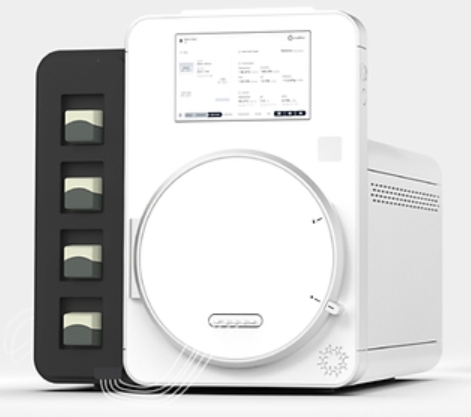
Photo Credit: NUS Singapore
Medical holography has emerged as one of the most promising applications in the medical industry. Holographic imaging technology is advancing healthcare, life sciences, biomedical research as well as medical training and education. Mixed Reality (MR) applications are gradually making a progressive impact on healthcare deliveries with precise quantitative measurement of human internal anatomy elements in 3D holograms geometries displayed in actual physical space. Holographic 3D technology renders medical professionals with advanced diagnostic capabilities and surgical planning, by allowing them to slice virtual tissue, organs, and other body parts at various angles. Holomedicne advances access to percutaneous procedures without invasive needle techniques. Surgeons across the world are now curious to explore medical holograms to enhance the efficiency of complex surgeries.
In contrast to AR/VR, in MR the real environment remains visible at all times and the holograms appear in the real space passing through a holographic device. This enables medical professionals to zoom in and zoom out the magnified 3D hologram of an organ/tissue under study. These visuals are indistinguishable in a conventional scanning procedure and thus holograms make treatments and surgeries a seamless effort with live explicit interactions.
Trends and opportunities in the medical holography market:
Geographically, North America represents the significant manufacturing and commercialisation segment of medical holographic imaging assets and is expected to account for the largest global market share from 2020 to 2025. But, the European market has been the slowest since 2019 and is expected to remain the same by 2024, says TechNavio Market Research report.
Nevertheless, APAC is considered to be the fastest-growing region in the medical holographic imaging market to emerge as a front-runner. Numerous economies in APAC such as India, Singapore, Japan, South Korea, China, and Indonesia have huge potential to extrapolate holography. The size of the medical holography market in the APAC is estimated to grow to $474 million by 2026 from $120 million in 2021 at a CAGR of 31.56 per cent during the forecast period, says Market Data Forecast, 2022 report.
Holomedicine
Surgeons across the world are now curious to use medical holograms to improve the planning of complex surgeries. The developers of the medical mixed reality platform are implementing MR tools to create virtual 3D avatars for streamlining surgical planning, patients engagements, and assisting in medical academia.
The term Holomedicine is derived from the word ‘hologram’ and describes MR medical applications where the holograms appear as floating images in the real physical ambiance. A consortium of clinicians, scientists, doctors, technical specialists, policymakers, and industry partners has established an international organisation called, “Holomedicine Association”, to nurture Holomedicine in the healthcare sector.
Diversified Potential of 3D Holography
The use of holographic imaging and projection has resulted in tremendous changes in the multidisciplinary field. Holographic imaging technologies effectively augment the learning capabilities in medical education, surgery, advanced medical training, clinical research, pharma/medical manufacturing, remote monitoring, and other associated areas.
Optimise healthcare deliveries and clinical operations: Holographic 3D technology renders medical professionals with advanced diagnostic capabilities, surgical planning, and interventional cardiology/radiology by allowing them to slice virtual tissue, organs, and other body parts at various angles. This enables the image specialists and interventionists/ surgeons to create an unlimited number of in-depth cross-sections views to investigate an organ or tissue in detail.
Biomedical and bio-pharma research: Holography microscopes have various applications in biomedical research, such as real-time monitoring of living cells, cell-based assays (such as cytotoxicity assays), defect inspection, and noninvasive analysis of fluid tomography using living cells and more which can aid in accelerating drug discovery and pharmacovigilance. Eventually, the pharma and bio-pharma sectors are also inventing multiple applications with MR solutions. Especially for reducing procedural non-compliance and increasing yields via remote data sharing to accelerate discovery and development, support clinical trials, and for training purposes.
Biomedical training and education: Over the years holographic technologies are gaining extensive acceptance in medical education and hospital training. 3D holographic perception creates an intriguing and intelligent learning environment by adding rotation flexibility to images dimensions, thus creating an interesting and interactive learning atmosphere. Further, immersive holography technologies help better knowledge retention among learning groups compared to 2D visualisation on a digital screen.
Removing stumbling blocks
The global medical holography market is valued at $1011.9 million in 2021 and is estimated to grow at a CAGR of 19.4 per cent, to reach $2938.1 million by 2027, according to Research and Markets, 2021 report. The rising adoption of holography products in medical education, biomedical research, and other clinical applications is also attracting investments from IT giants encouraging allied product and software development. However, the requirement for high capital investment and the cost of the technology might hinder the growth of this market during the forecast period.
Though the medical holography market is anticipated to witness significant growth, the computation cost of processing holograms can be an influential factor to slow down the growth of the medical holography market.
“The development of holograms is a considerable cost-intensive process. It takes significant investments in R&D to develop new products that effectively cater to market needs. The high costs associated with research and technology development (which includes product development, system engineering, software development, clinical assessment, and concerned regulatory approvals for the initiation of product manufacturing) increase the cost of the final product. The most expensive component of a digital holographic microscope and digital hologram is the computer that is used to reconstruct images. Various end-users, especially academic institutes, cannot afford these high-cost tools, which might strain medical holography growth in the market to some extent. However, with the availability of faster computers for image processing, inexpensive semiconductor lasers, and high-speed CMOS cameras, it would be possible to build holographic products at lower costs in the near future”, explains ‘Seeking Alpha’, a crowd-sourced financial market report.
Furthermore, virtual technologies always demand high bandwidth networks for operating smoothly. Hence integrating the MR technologies with 5G can boost the data transmission speed for an uninterrupted holographic view. Features of 5G, such as high transmission, large bandwidth, and low latency, can enrich MR application scenarios. Thus, in a way, 3D holographic technology largely depends on the high-speed internet for data-intensive tasks and might experience substantial temporary glitches in countries that are yet to adopt 5G network services. Though 4G can support many holographic features, capabilities are optimised with 5G.
Anticipating competitive landscape
The fast-paced life is demanding expedited results of clinical examinations and thus working closely with AI diagnostic systems to attract clinicians and instigate educational transformation. Holography will significantly disrupt 2D/3D imaging, as it offers better usability and addresses the shortcomings of current 3D solutions. Progress in image-guided therapies and operational procedures has opened new frontiers for minimally invasive, non-surgical interventions.
The possibilities and implications of Mixed Reality’s continuous growth demonstrate that the future of MR is both realistic and limitless.




